Newsletter
Good stuff? Follow along on twitter, via RSS, or sign up for occasional updates via email.
I just published Humans of AI, an online exhibition of three pieces based on my reverse-engineering of the COCO image dataset. The series restores attribution for the dataset's unwitting contributors. It exposes the myth of magically intelligent machines, instead applauding the photographers who made the technical achievement possible. — http://humans-of.ai

I'm fortunate to participate in two shows in Milan this Spring: Raising Robotic Natives is part of Broken Nature at 22nd Triennale di Milano (Mar-Oct), curated by Paola Antonelli with Ala Tannir, Laura Maeran, and Erica Petrillo. And The Chair Project was shown in Interfacce del Presente at BASE Milano in March, curated by Link Art Center's Tiziana Gemin and Fabio Paris.

I am working with a Danish furniture and artisans on a new version of The Chair Project for Uncanny Values at the MAK Vienna. We made four new, AI-generated-human-built chairs in full scale and Scandinavian furniture design tradition. Humans working for a machine — not as dystopia, but as opportunity. Please join me for the opening on May 28!
Good stuff? Follow along on twitter, via RSS, or sign up for occasional updates via email.
Long time no note — I've been busy. Last week I took a break from working on my MFA thesis to teach a workshop on Machine Learning for Designers at my alma mater, HfG Schwäbisch Gmünd in Germany. More on that soon.
On December 1st, I'll be at New York Tech Zine Fair with my friend Aarati Akkapeddi and many other exhibitors and publishers. Stop by!
December 2nd we're having a small popup exhibition for work-in-progress at Parsons, and December 6-9th I'll be in Montréal at NeurIPS to present a paper/poster about the Chair Project at the Machine Learning for Creativity and Design workshop.
Super excited for all of this + already tired.
Summer break is over. I went places, almost got eaten by a bear upstate, ran a 11km race on Cape Cod, and had a good time overall.
Over the Summer I worked with Daniel Sauter on a research project for which I designed and built a prototype using using blockchain (not exciting) and IPFS peer-to-peer web technology (quite exciting!).
I also taught a three-week creative coding summer class for incoming grad students, which was a very rewarding challenge! I learned a lot and want to teach more in the future. In fact, I'll be a Teaching Assistant in the MS Data Vis program at Parsons this Fall.
Speaking of Parsons: My second (and final) year of grad school has begun and I am very excited to spend the next nine months working on my thesis project. It'll be in the realm of critical investigations into machine learning, but I don't know the specifics yet. What I know is that I am taking super promising electives that'll shape my thesis: A MA Media Studies class called Data, Archives, Infrastructure with Shannon Mattern (finally!); and Concept Work and Materialization with Dunne & Raby and anthropologist Janet Roitman in the Integrative PhD program. Let's go!
Most of my work is connected through the domain of computation. For me, computation is at the same time subject, material, and tool. Ultimately, it is a source for a fascination that hasn't faded for many years. When I talk about computation as a subject I don't mean the basic building blocks like math, semi-conductors, or assembly language, but rather how computation relates to the world more broadly.
The Encyclopedia of Cognitive Science begins its article on “Philosophical Issues about Computation” as follows:
‘Computation’ is a cluster concept and has been characterized in many different ways (e.g. ‘the execution of algorithms’). It underwrites philosophical analyses of what can be done in principle by a mechanism, and is intrinsically connected to the idea of manipulating symbols or representations by formal rules. [...] The notion of computation is undoubtedly one of the very central, increasingly influential notions of our time.
I find this definition useful in multiple ways. Firstly, “what can be done in principle by a mechanism” suggests a creative space for designing; the wide disparity between what is possible in principle and in reality offers pathways into numerous topics and even existential questions.
Computer vision, for example, has been technically feasible for a while. Still, it remains challenging for a computer to keep a car on the road or distinguish dogs from bagels. I think it is fascinating how we choose to represent the world for computation and how computation builds representations of the world; how we see computers and how computers make sense of us. These themes, it turns out, are as much about us humans as they are about computers. And I believe that all the friction and problems, lucky accidents, the good and bad glitches, help us to see differently. We can use technology to reflect about ourselves.
Secondly, to come back to the definition quoted earlier, computation being “one of the very central, increasingly influential notions of our time” illustrates the greater relevance of engaging with computation in my practice. Many emerging technologies are made possible by computation and come with potential applications and implications for their users and non-users, societies and the planet in general. My goal is to add my voice to the countless others studying them, hopefully contributing to more thoughtful use of computation.
It is summer. I was on vacation. I am working with Daniel Sauter as a research assistant and preparing for my MFA thesis in the Fall.
In May, Irene Alvarado and I hosted a meetup for creatives working with machine learning. It was a bit of work and a lot of fun!
Stephan and I showed Human Element Inc. and Camera Restricta at Lodz Design Festival in Poland.
And, this is the most exciting thing for me, Bromide Books has published my book, Computed Curation:
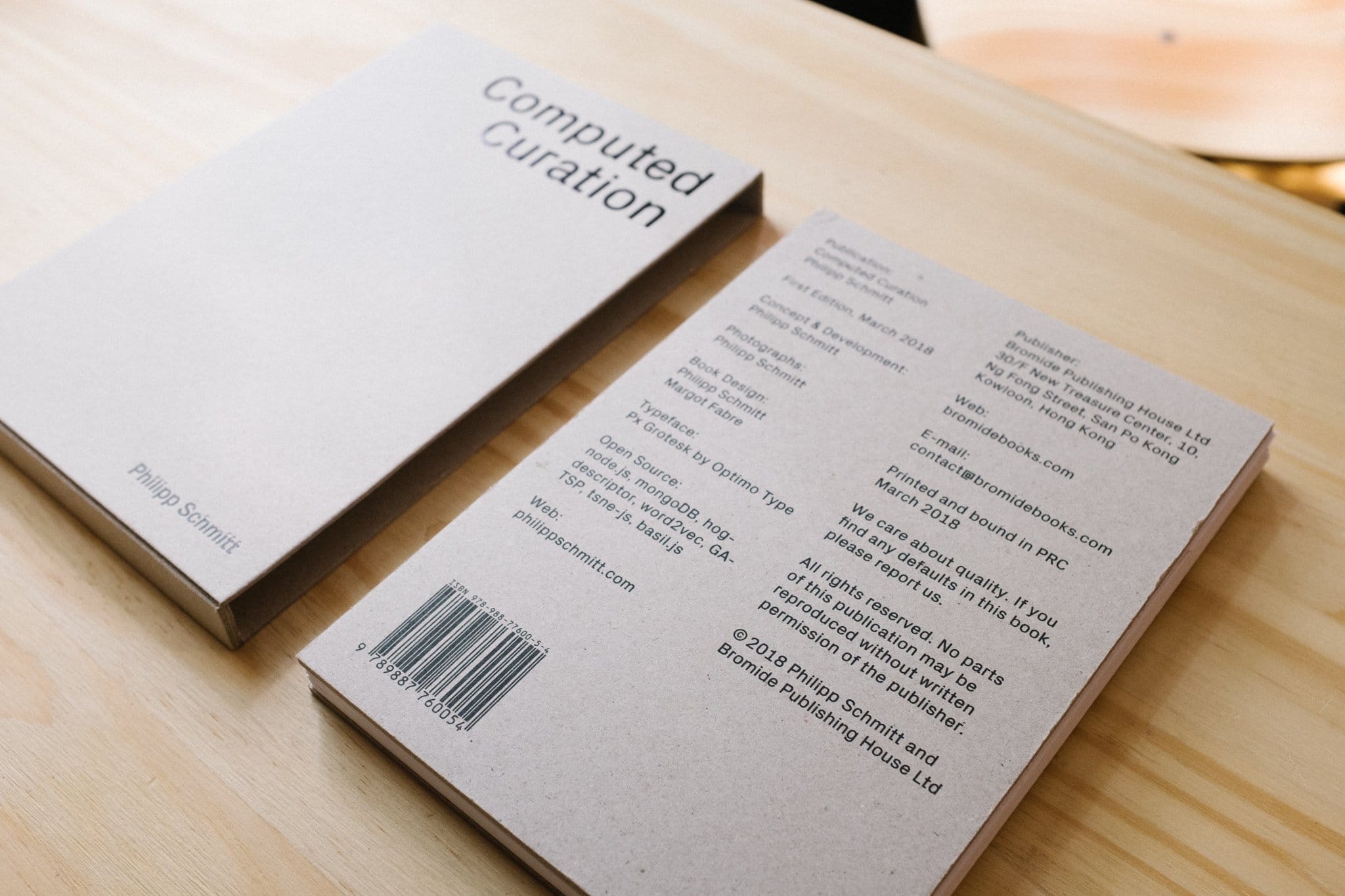
You can get it here.
These notes barely deserve the name 'week notes' any more; and even 'monthly' is getting hard to justify. Oh grad school...
In the past two months I spent more time than usual talking: Jonas and I gave a talk about robots and speculative design process at the NYC Speculative Futures Meetup in New York. Then I taught a data visualization workshop at Parsons and was a guest critic in Shannon Mattern's (who is brilliant!) Urban Intelligence class at The New School. All of these were great experiences — intimidating at first, but rewarding throughout.
Behind closed doors, I am in the process of wrapping up a few projects and experiments with generative machine learning that I can hopefully share soon. There's a hint or two on my work-in-progress tumblr, officeps.tumblr.com.
I've begun my second semester at The New School, hence the lack of weekly notes. I am continuing a class on ‘designed realities’ with Dunne & Raby, a Machine Learning intro in Parsons' Data Vis program, and a studio with artist Ernesto Klar. I am still focussing on machine learning and computer vision tech, both as subject of investigation and medium for making.
To be able to deep-dive into this, I initiated a small machine learning lab (aka. currently a computer in a tiny, windowless room) at Parsons that is now finally up and running.
In other news, the talk I gave about Computed Curation at the Ammerman Center for Arts and Technology 16th Biennial Symposium is online here (at 00:07:45). Note to self: Try to smile more, sound more excited.
MIT SENSEable City Lab launched City Scanner, my main project at the lab. I had the pleasure to work with incredibly smart people and learned so much about research, close collaboration with scientists, thermal cameras, and garbage trucks.
I haven't written a weeknote in nine weeks, neither addressed the New Year three weeks ago or waited another two for the anniversary of my move to the US. Oh my!
2017 was significant for me professionally as well as personally and I really feel extremely thankful for all the good things that happened to me through hard work and a whole lot of luck.
Since the last note, I was lucky enough to be awarded a Second Prize for my project Computed Curation at the NTU IPA Photography Award.
The project is also nominated for an Infinity Awardhttps://www.icp.org/infinity-awards at the International Center of Photography.

In January I opened my first duo exhibition (together with filmmaker Markus Wulf) at the Consulate General of Germany in New York. I also had the opportunity to create a new project for the space: A Computer Walks Into a Gallery ... Filling a whole gallery myself was a new experience for me, but was a great opportunity to look back on all the things I have done over the last years and put them in perspective.
Roads to Rome is part of an exhibition at Northeastern University in Boston: The Art of Networks presents recent visualizations of complex networks.
Finally, I am currently looking for an internship (or really any mode of working) over the Summer in the New York or Boston area. Any leads? Let me know.
In the periphery of the landscape that is the current boom of machine learning (ML) sits a playground for tech-savvy creatives who re-appropriate the technology for their means.
In one corner, there are designers focussing on applying the strengths of neural networks to their field. They dream up new “intelligent”, generative tools that, for example, help them analyze data or produce a thousand variations of a design to select the best [1].
In another part of this playground are artists interested in the new medium's own expressiveness: “[ML] is becoming a tool, just like painting”, artist Trevor Paglen told me at the opening of his recent exhibition [2]. Paglen and other artists like Mario Klingemann and Sascha Pohflepp have recently produced interesting visual work — let's call it machine learning art (MLA) — that prompted the thoughts behind this essay.
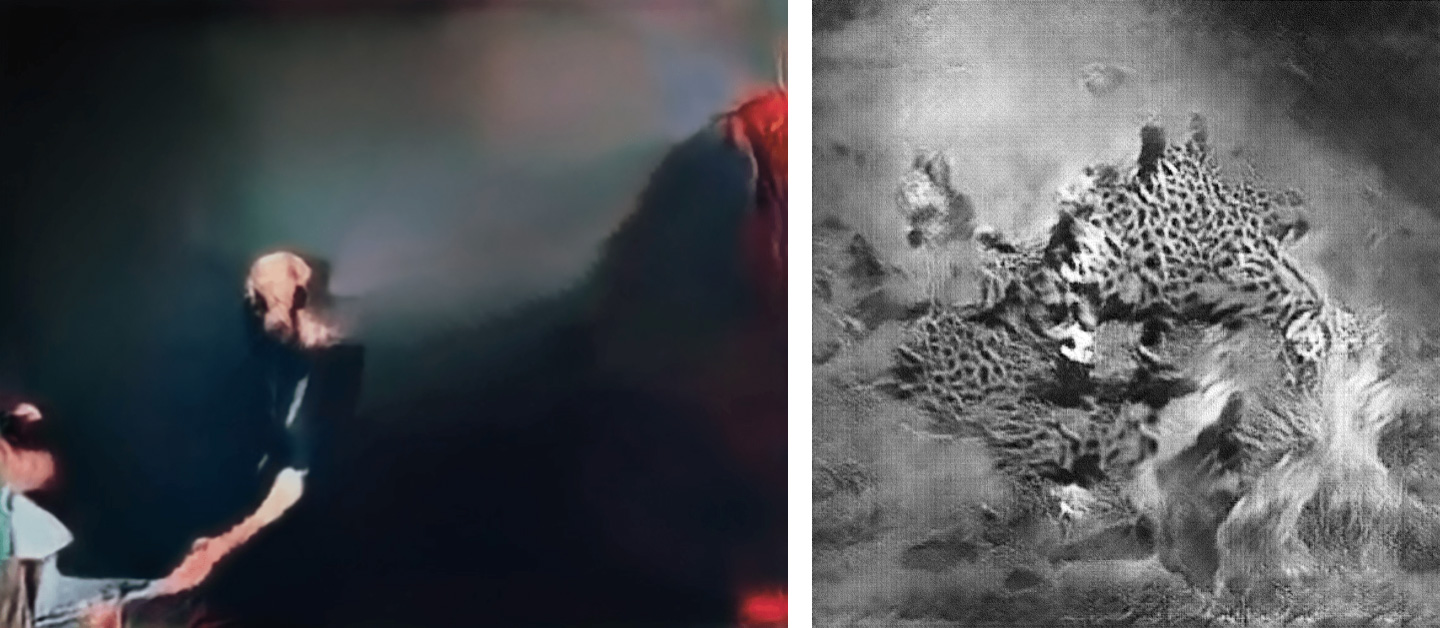
These images are similar in their their visceral evocative qualities, their organic “brushstrokes” and textures, their surreal creatures and objects. They are usually made to depict familiar objects and draw from visual material of this world, but have something alien to them that fascinates me.
The technology to make these works wasn't invented for or by artists. The scientists and engineers around our playground use these images as well (but tend to discard them after). They use them to better understand how their neural network works — or doesn't. In other words, the images — as debugging tool or artwork — often tell us more about the machine itself and the people who made it rather than about the depicted subject matter. [6]
MLA is interesting because of the network's tendency to mis-represent or represent in alien ways. The glitches in the system make the fascination. As researchers are working on making the technology more accurate and explicable, its associative potential decreases. Any sufficiently advanced MLA system loses its magic, so to speak.
The works remind me of the paintings and drawings of Surrealist artist Max Ernst. Surrealists like Ernst sought to resolve the — in their opinion — previously contradictory conditions of dream and reality [3]. They borrowed techniques from psychoanalysis to stimulate their art, believing that “the creativity that came from deep within a person’s subconscious could be more powerful and authentic than any product of conscious thought” [4].
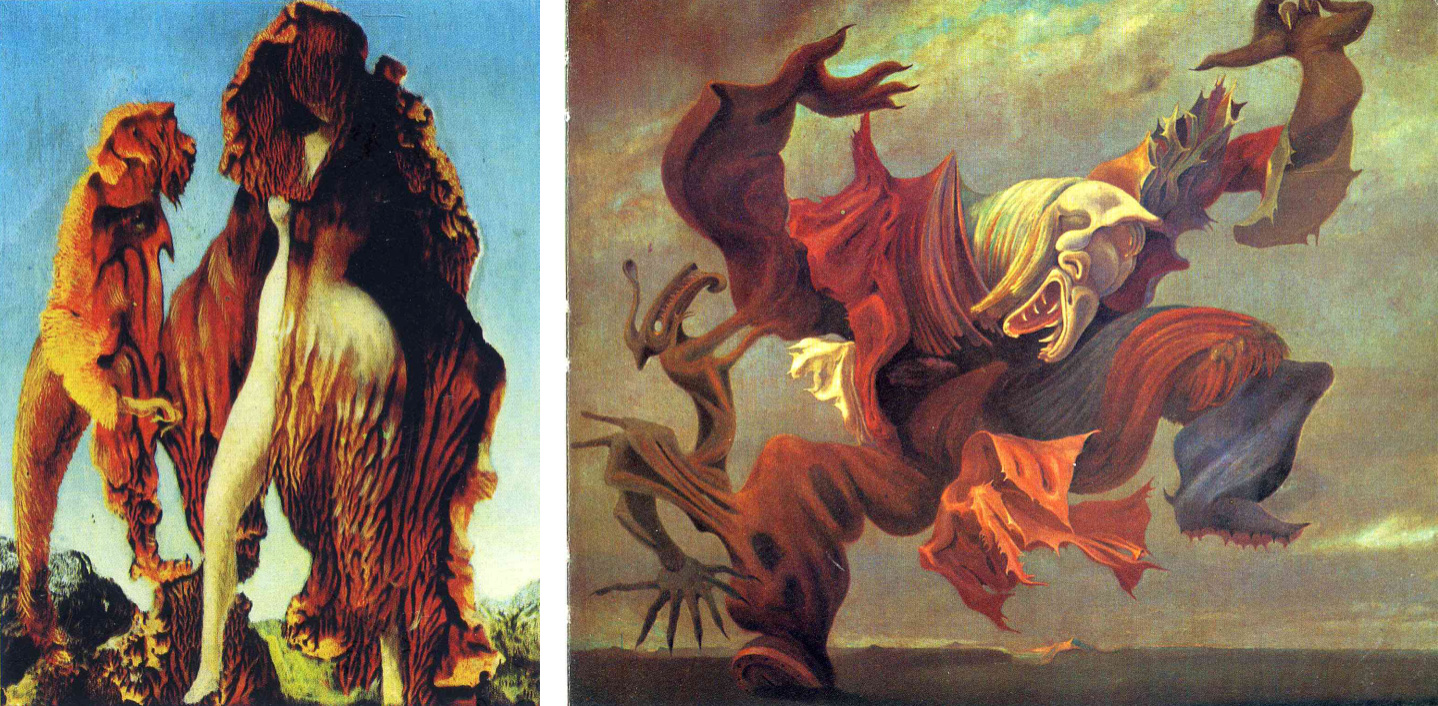
I will not proclaim Paglen, Klingemann, or their computers as contemporary Surrealists. Rather, I want to compare MLA with Surrealist technique to propose a different way of thinking about machine learning as a creative tool. Imagine looking over to the corner of the playground where the designers are playing. I want to explore the space in-between.
MLA does not adhere the Surrealist movement, but its techniques. The Surrealist artist's toolbox features a whole range of “automatisms” — techniques for making art that poke the subconscious, so to speak. In physiology, the term automatism describes automatic bodily movements. We usually don't consciously control our breathing, for example, and that is what automatisms are supposed to achieve for making art [9]: “Pure psychic automatism ... the dictation of thought in the absence of all control exercised by reason and outside all moral or aesthetic concerns” [3]
There are many automatism techniques. Let us look at one that every kindergartener knows: Frottage. Frottage is a technique developed (not invented) by Max Ernst in 1925. This technique picks up textures from structured surfaces by placing a sheet of paper on top and rubbing over it with a pencil. [5]
Frottage starts with an object (fig. 1). By transferring the object's textures to a canvas or piece of paper, the artist creates a two-dimensional abstraction of the object. Often, multiple frottages are combined on a single sheet. The textures form evocative images. They prompt connections to other, often unrelated objects, places, or creatures that the artists responds to by refining the image to bring out more the desired subjects.

MLA often follows a similar process (fig. 2). Leaving aside technical details, this process can be generalized as follows: It starts with a dataset of thousands or tens of thousands of objects (or digital representations thereof). Through training, the artificial neural network creates a high-dimensional abstraction of the object’s features: the model. A model can be made to visualize what it “sees”. It shows us textures and shapes somewhat characteristic to the object in ways that often look similar to frottage.
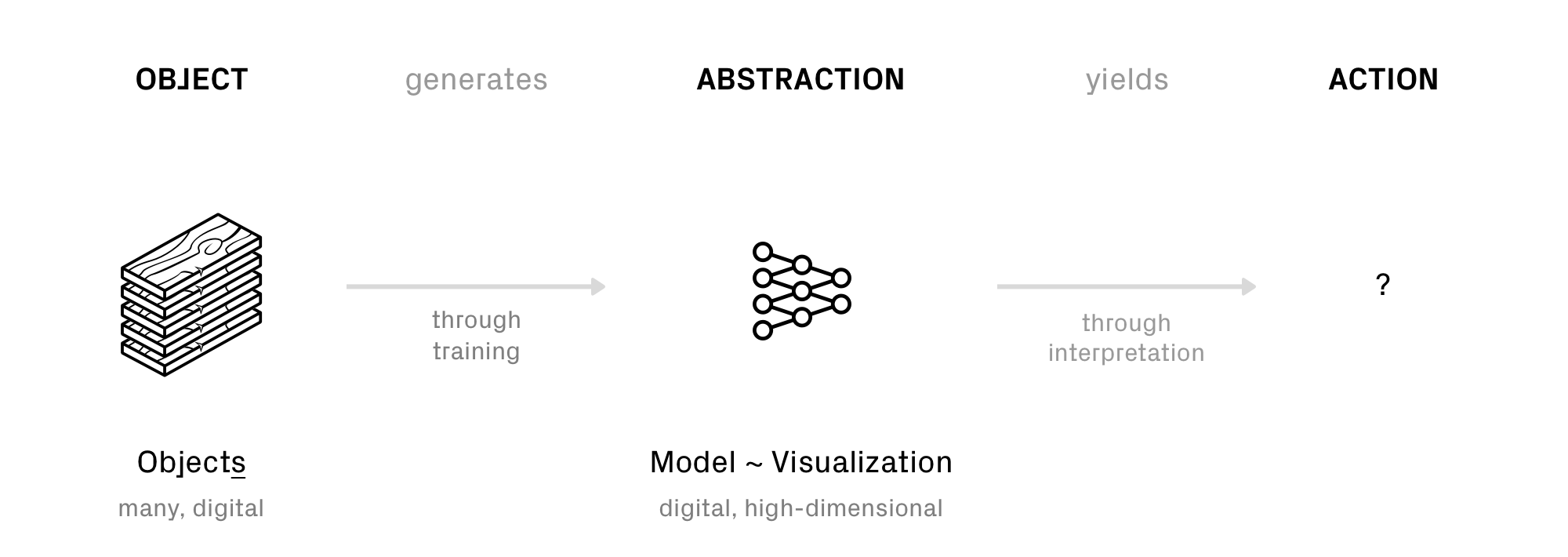
I would argue that both processes create images with similar evocative qualities or potential. But there are, of course, also differences between the two. One is that neural networks inherently strive for representation whereas frottage and Surrealism in general seek to dissolve it.
Another striking difference is that frottage is generally used to launch an artistic process whereas MLA usually is not. And this, finally, brings me to the point of this essay.
Max Ernst published his experiments with frottage in a 1926 publication titled ‘Histoire Naturelle’. The drawings in the series aren't just rubbings that leave the interpretation to the viewer. We see fantastic landscapes and creatures — rendered with the precision of scientific illustration — inspired by what Ernst saw in a piece of wood. [8] The frottage was the start of a process rather than the end of one.

As I have shown earlier, in current, early MLA the images mostly stand for themselves as artworks. The tool itself is the center of attention.[7] In a way, they stop where things get interesting.
What if we employed this means of making images neither as practical debugging nor as art in itself? But rather as an art and design tool for mind bending — like Surrealist frottage; one that caters to the subconscious, the associative, the imaginary rather than rationale?
TV channels ARTE, BR and ORF have co-produced Homo Digitalis, a series on what being human might mean in the future. For the first episode they made their own robot baby feeder from our open source files and reenacted Raising Robotic Natives — with a real baby! Seeing this is incredible for me.
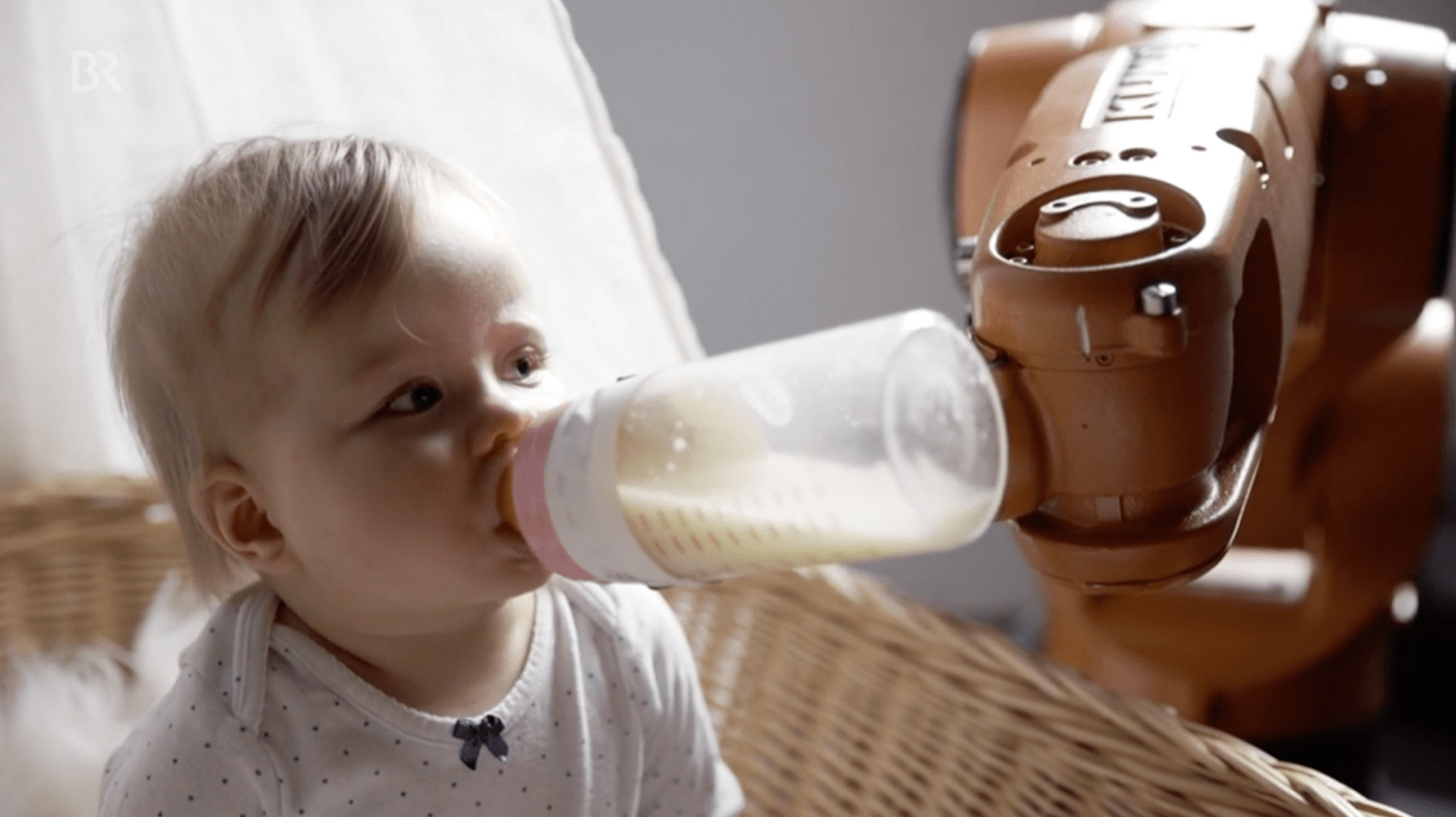
You can see the full episode here.
On the ground, school is keeping me busy thinking about machine learning and surrealism as well as fungi and skin stretching. More on that soon.
I'm excited to start a new position as Research Assistant with the Designed Realities Lab at The New School. Led by Anthony Dunne and Fiona Raby, the lab “combines design with social thought and the liberal arts in order to develop alternative narratives to technological futures”.
Exhibitions have ended at VISAP'17 (Computed Curation), MAK Vienna (Raising Robotic Natives), and AI Lab Vienna (Human Element Inc). I'm very greatful for it all and can't wait to share the new things coming up!
Other than that, New York is tough. New York is overrated. New York is great. Still figuring out what to make of it all.
I've recently been thinking about aesthetics in machine learning (visual) art. One one hand neural networks generate unforeseen, often bizarre and fascinating results. On the other hand the style of these outcomes is often very similar, if not uniform. I don't have a fine arts background, but associate this particular style with abstract and surrealist painting.


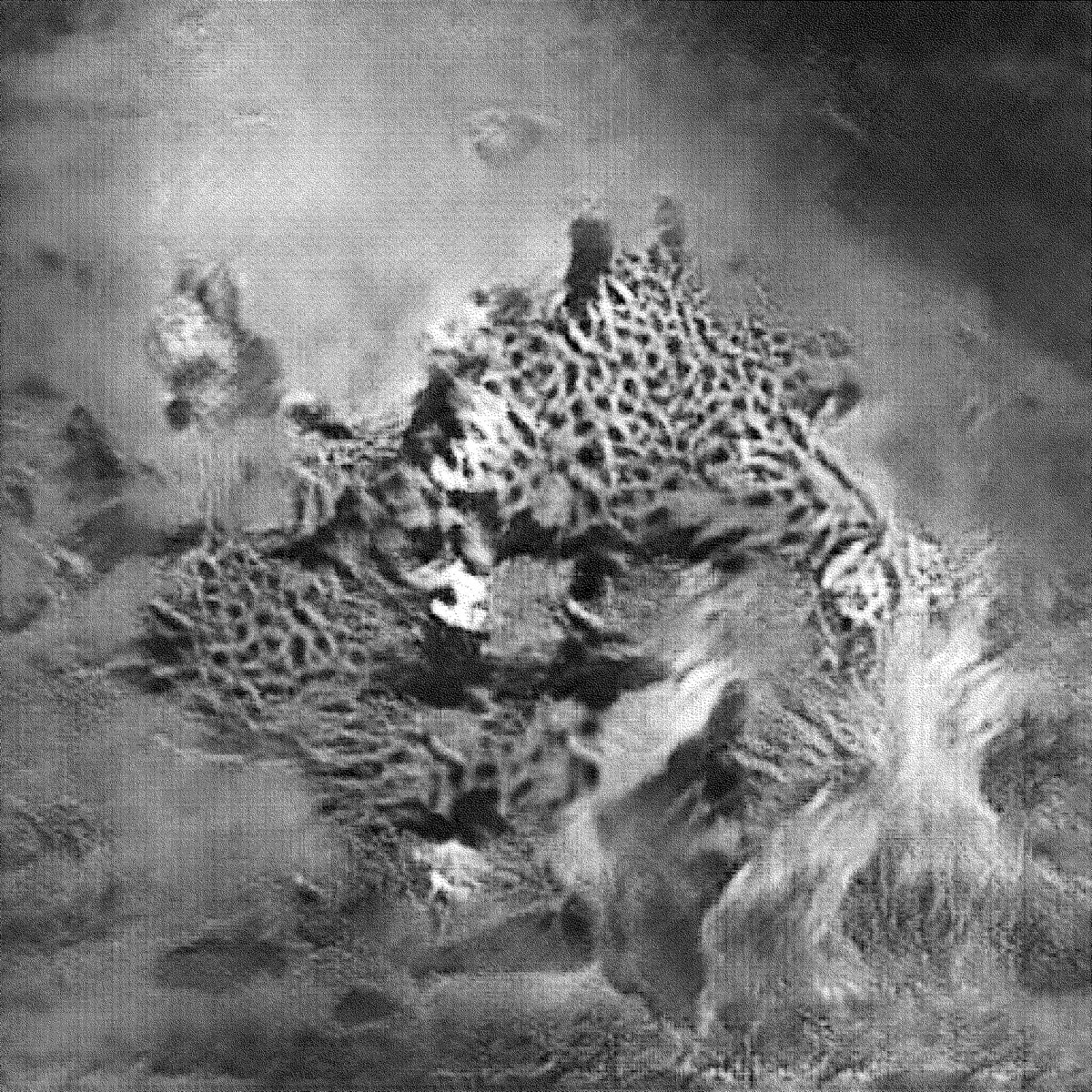
When I saw the opening of Trevor Paglen's latest exhibition ‘A Study of Invisible Images’ last week, I was again struck by how the style of his latest work is in line with other artists using the same tool.
I asked Paglen, who was present at the gallery, about this. He replied that machine learning “ is becoming a tool, just like painting” and continued that he is more interested in the training data used to create the images. And indeed, what makes Paglen's show great are the politically loaded training sets very much in line with his previous work.
Lacking my own wisdom, I am closing this note with a quote by Klingemann about how he sees this issue developing in the future:
As with any new technology, we’re in an early phase where the tool itself is the center of attention. [...] deep learning will become just another tool for anyone to use. Then we’ll see who does so in artful ways, who finds unique ways of expression.
I am two weeks into my Master's program at The New School in New York. Just moving to this city would be overwhelming as would just starting graduate school. Doing both all at once is a lot to take in and process. All of this leaves me simultaneously exhausted and excited.
In other news, Computed Curation, my machine-learning photobook, will be shown at the NYC Media Lab '17 Summit at The New School on September 28th. Afterwards, for October 1st-6th, the book is travelling to VISAP'17, the arts program within the IEEE VIS Conference in Phoenix, AZ.
I am excited to show the project to two quite different audiences and have interesting discussions around it. If you're in New York or Phoenix these days, come see the real book and have a chat!
I left MIT at the end of July, travelled home to Germany, got a new visa, spent a nice couple of weeks with friends and family, and am now back in the US. In a new place to become home: New York City!
Working with the researchers at Senseable City Lab taught me lots of things and has been a truly great experience. I am lucky to have had such an amazing first, post-college job! Back in the bubble that is design school, I am excited for what's ahead at the New School and in New York — details forthcoming.
Other things: QUAD in Derby has published an album of photos of their exhibition Machine Made, in which we're showing Raising Robotic Natives.
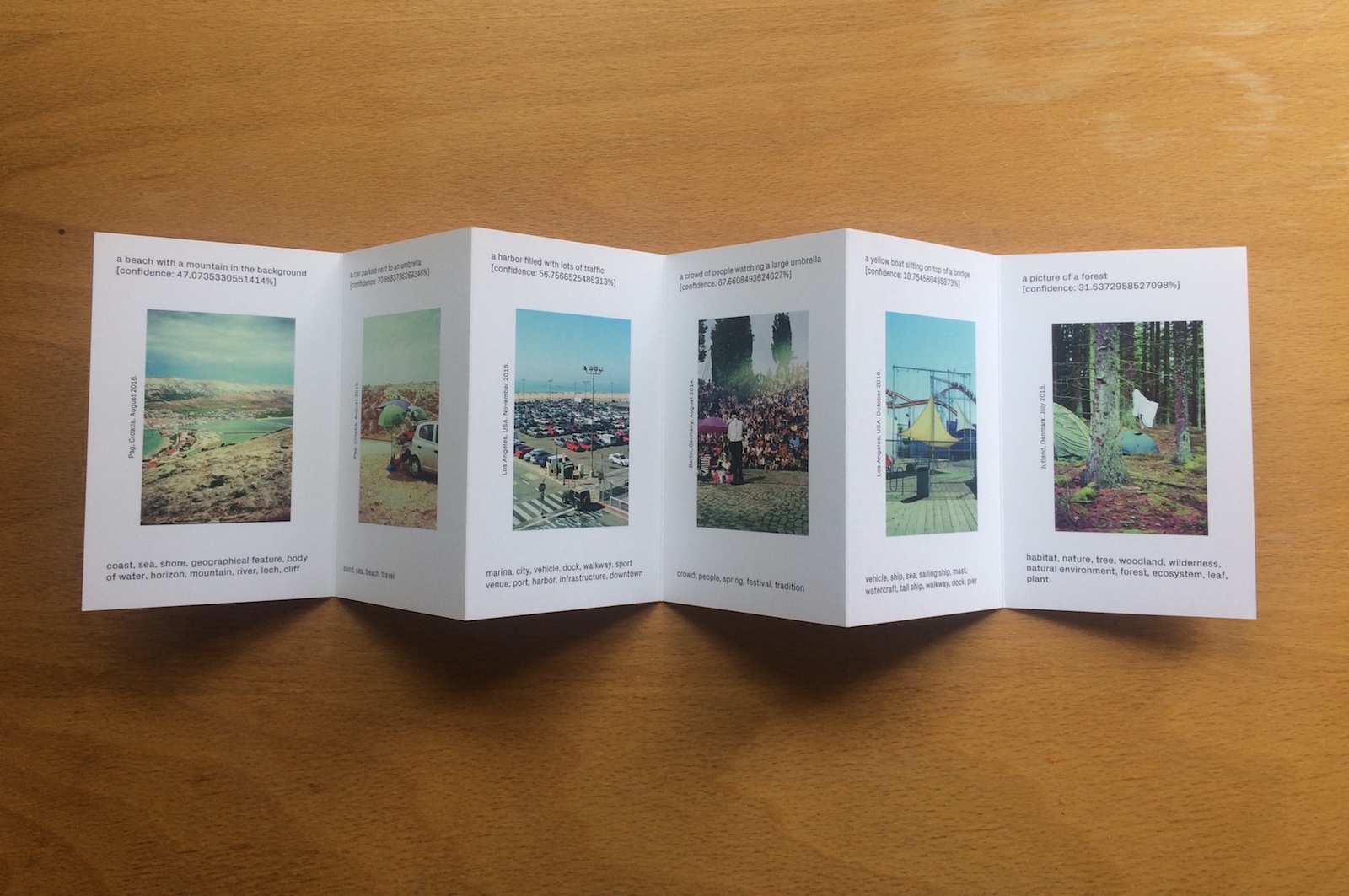
Also, I am selling a limited run of Computed Curation mini leporellos. Those are 10x15cm, 10 image booklets for 10€ + shipping. Email to order.
Superflux has posted some photos of How Will We Work?, an exhibition at Angewandte Innovation Lab for Vienna Biennale. I'm glad to be a part of this!
It feels good to have Computed Curation, my side project for the last six months, finally out of the door. It received interesting feedback and I am currently looking into ways of producing an edition of the book for you to buy.
A big thank you goes to graphic designer and illustrator Margot Fabre for helping me with the book's layout... But wasn't this book supposed to be made by a computer? Quoting Jesse Rosenberg of design studio Nervous System:
Algorithms don't design things. People design algorithms. Algorithms generate output.
My time in Boston flies and I'm slowly getting nervous about leaving.
Stephan and Jonas travelled to Vienna to see the opening of the Biennale (we're showing two projects) and welcome a new robot to the family:

Our trusted yellow Fanuc “Dirk” had to go home to HfG Gmünd and was replaced by a Mitsubishi MoveMaster II.
Raising Robotic Natives will also be shown in a small exhibition titled “Machine Made: Art, Robots and AI” at QUAD in Derby, UK.
It took nine months of research, emails, travel, applications, writing, and finally waiting to sort out what I'll be doing next: I'm starting a MFA in Design and Technology at Parsons (The New School) in New York City!
DT is a studio program surrounded by a diverse university surrounded by arguably one of the most exciting cities in the world. I hope to find within that the freedom and support to follow my personal research interests and to grow as a designer and person. I can't wait to finally get going in August!
Something else: SEEING, the exhibition at Science Gallery Dublin that Stephan and I contributed to, has now travelled to Frost Museum of Science in Miami, Florida. That's cool, especially considering that our piece was stuck in customs in Bengaluru, India, for a couple of months! The exhibition is on view through October 20, 2017 and the Frost looks like an incredibily cool place to visit (they have sharks, too).
I am currently finishing a new project that will hopefully be released soon. Until then, follow along on my work-in-progress feed.
Human Element Inc. will be part of “How Will We Work?”, an exhibition by the University of Applied Arts Vienna in cooperation with the Vienna Biennale 2017.
The exhibition How Will We Work? will address, in both analytical and speculative ways, future forms and functions of human work, particularly targeting the role of the creative sector. With a view to the disappearance of seemingly "traditional jobs," it will raise the question about who will, and should, actively participate in redefining the terms work and future.
Stephan and I are honored show our work among many great designers and artists and look forward to the exhibition! You can see “How Will We Work?” between Jun 21 and Sep 27, 2017 at Angewandte Innovation Laboratory (AIL).
This anniversary note marks one year since I started writing weeknotes. The format has proven to be a fun way for me to keep track of what's happening outside of project release cycles. So here's to year two!
Two weeks ago I gave a guest lecture in a ‘Digital City Design’ class at MIT's Department of Urban Studies and Planning, which was super fun!
Human Element Inc. is featured in a great PAGE mag article on speculative design and I was interviewed together with Stephan for german magazine agenda design. It's weird to see your own statements appear as if they were facts although you know nothing, like anyone else.
I can't believe it's already (almost) two months since I started at MIT. Working at SENSEable City Lab is great not only because of the projects, but very much for my great colleagues (and of course all the free food on campus).
I want to share more work in progress rather than releasing only finished projects. That's why I've started another tumblr titled Work in Progress from the Office of Philipp Schmitt. Let's see how this goes.
Also, the talk I gave at This Happened #3 in Brunswick in January is online now. It's been the first time for me to speak publicly about my work and I like to think I didn't do too bad. There are two articles that I found pretty helpful preparing for this event: this one by Zach Lieberman and another one by Jer Thorp. Here's what I did:
Thanks to the great students and Prof. Michael Jonas at HBK Brunswick!
Mid February I moved to Boston (or more precisely: Cambridge, Massachussets) for a new position as Reseach Fellow at MIT SENSEable City Lab. Here, I am working on data visualizations for upcoming lab projects. And after one month in the US I have also gotten used to daily life and the exciting place that is MIT.
Two weeks ago my friend Margot Fabre launched a new portfolio website that I designed and developed. She's a great graphic designer, illustrator, and person based in Toronto, Canada. Take a look at her work on margot-fab.com.
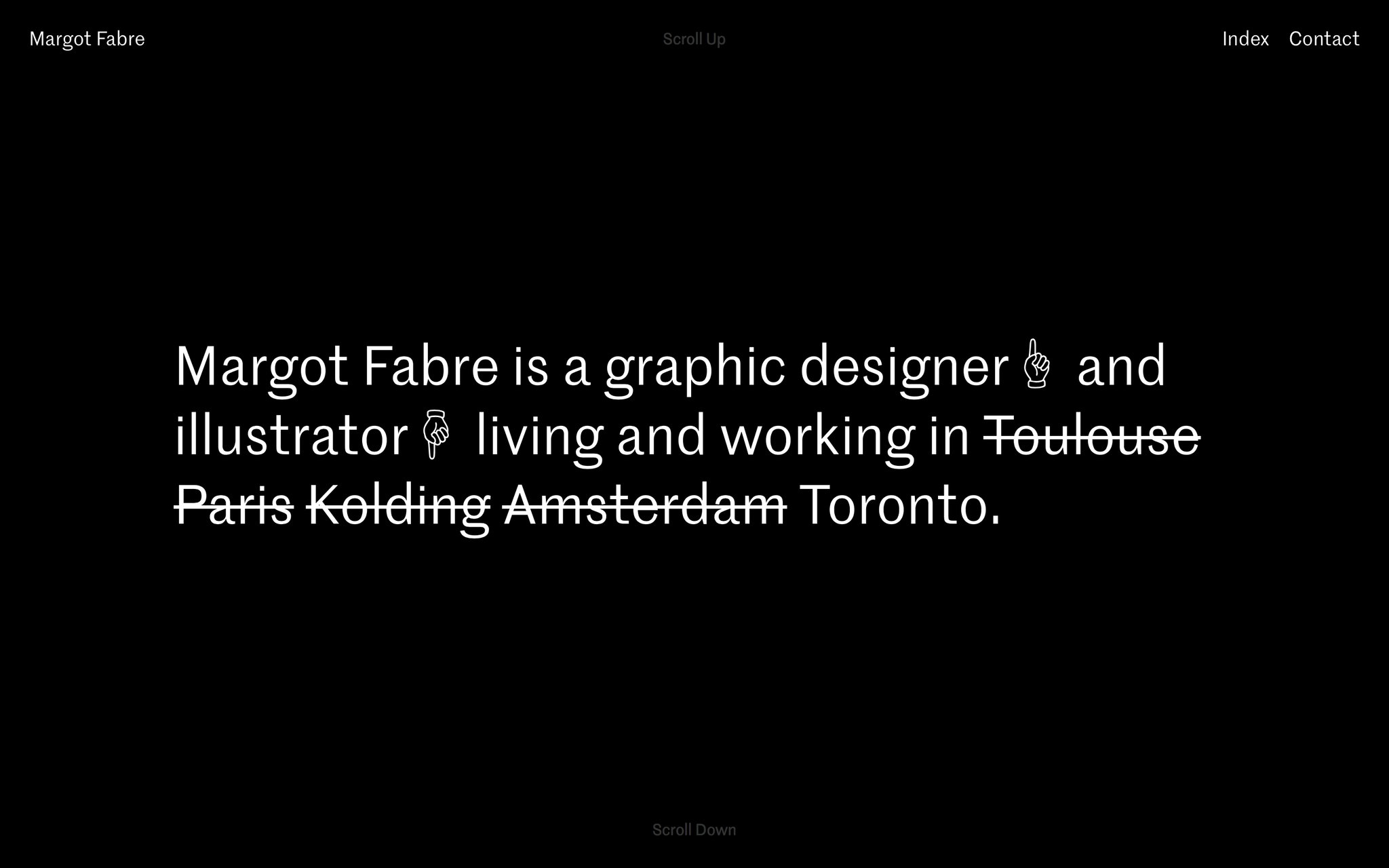
And on a final note, Roads to Rome was awarded a Jury Selection at the 20th Japan Media Arts Festival! Needless to say, the moovel lab crew and I are stoked. 🚀
Stephan, Jonas and I spent three days at the Vitra Campus in Weil am Rhein to set up our exhibit for Hello, Robot. Design between Human and Machine at Vitra Design Museum.

The opening was a truly memorable experience, especially because we get to exhibit next to many exceptional artists and designers that inspired our project in the first place. Jonas has put it nicely on his blog here.
I highly recommend seeing the exhibition! If you're not sold yet: they even have the original R2D2 model from the first Star Wars movie! “Hello, Robot.” is open until May 14th, 2017 in Weil am Rhein (near Basel, CH). Or read about it on Designboom and Wallpaper.

Oh and btw I live in Boston now :) More about that soon.
January was a month dominated by submitting Master's applications (a full-time job really) and preparing for a new position:
From February 15th I'll join MIT's Senseable City Lab in Boston as a Research Fellow with a focus on data visualization and creative coding.
I am really excited about this opportunity to work with and learn from the bright people at MIT! Until recently, I was also excited about moving to the United States. However, now that the new US administration has taken a course with undermindes many of the values I cherish as a European, some of that excitement has faded. At this time, I am not sure how to respond.
Something else: This weekend someone posted the Camera Restricta movie on Reddit's /r/photography, which was followed by an interesting discussion (and sent the video views past 300,000 plays).
While many users brought up valid arguments, there was again the usual portion of hate and misunderstanding. Although this surely is (to some extend) inherent to the internet as a medium, I noticed how again and again people get upset by the technical details. I was always aware that you can't judge the quality of a potential photo by counting the geotags nearby. I was simplyfing to make a point. Still, this is what people get carried away with, missing the overall idea.
My takeaway for future projects is to give away less of the technical implementation and create a more of a black box that opens up for imagination.
Happy new year! After dropping my external harddrive for Christmas, many hours of the past weeks were spent recovering files from the cloud (it sucks). Lesson learned: always keep an on-site backup.
Still, 2017 is off to a great start. I will give a talk about my work at This Happened, a “series of events about the stories behind interaction design.” I have never done this before. See you on January 25th at HBK Braunschweig, DE.
There's another thing that has been cooking for a looong time. Jonas, Stephan and I along with Raising Robotic Natives are part of an exhibition at Vitra Design Museum! It's incredible.
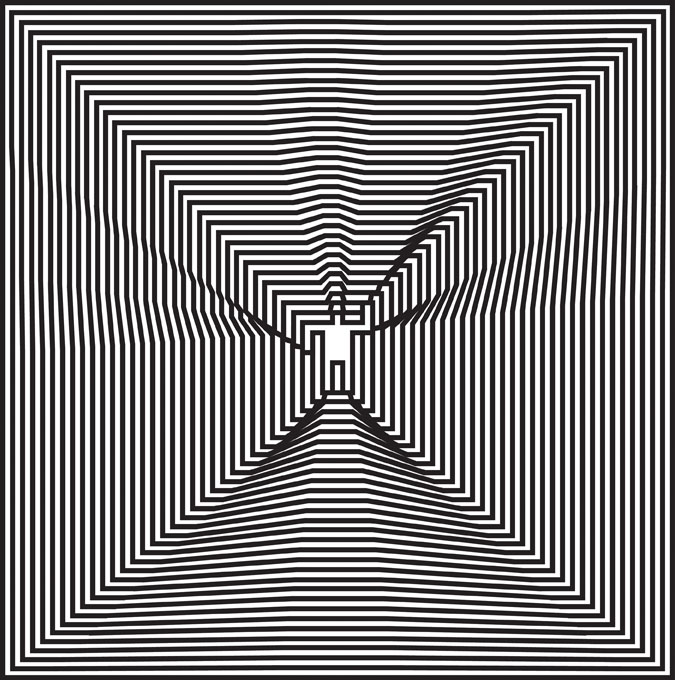
“Hello, Robot. Design between Human and Machine” opens February 10 at Vitra Design Museum in Weil am Rhein. I'm super super excited to be part of this, especially amongst so many great artists and designers that actually were an inspiration for our project.
[…] Vitra Design Museum thoroughly examines the current robotics boom for the first time. The exhibition presents a variety of exhibits, including examples of robots for the homes, industry or medicine, but also media installations, computer games and examples from film and literature. It will demonstrate how robotics is changing our lives today – and how design is changing robotics. At the same time, it broadens our perspective ofthe ethical and political issues associated with robotics today. The show features more than 150 objects including works by Bruce Sterling, Douglas Coupland, Joris Laarman, Carlo Ratti, Dunne & Raby, and Philip Beesley.
See you at the opening?
This note marks 36 weeks since I wrote the first weeknote on May 1st. Although I didn't post every week (14 weeknotes), I consider the whole thing a success. Turns out, other people actually read them too. This lead to a couple of interesting conversations and even to making a new friend.
Having a public notebook (and a geeky command line interface for writing and publishing) also got me to write four “non-weeknote” posts. Those articles, although admittedly only reciting passages from books, make me want to write more original content in 2017. It's just somehow scary to publish your own thoughts. Let's see.
2016 was great for me professionally, mostly because rewards for projects from 2015 turned up throughout the year. The most exciting part was getting to travel to Ireland, Switzerland and the United States to see exhibitions of my projects. I feel pretty lucky :)
Next year is set to be just as awesome and I can't wait to share what's coming up. To keep this a recap, I'll push that to next week. Have a Happy New Year, everyone!
I finally got around to start reading Susan Sontag's On Photography, which is essential reading that I should have done before or while working on Camera Restricta and that I picked up in many bookshops — around the globe really — but never ended up buying.
At the beginning of the book, describing the camera as “the device that makes real what one is experiencing”, Sontag makes the point that tourist photography both certifies and prevents the experience that is being documented.
It's a lenghty quote I'm afraid, but read on until the end! I think it's quite funny:
As photographs give people an imaginary possession of a past that is unreal, they also help people to take possession of space in which they are insecure. Thus, photography develops in tandem with one of the most characteristic of modern activities: tourism. [...] Photographs will offer indisputable evidence that the trip was made, that the program was carried out, that fun was had.
A way of certifying experience, taking photographs is also a way of refusing it—by limiting experience to a search for the photogenic, by converting experience into an image, a souvenir. Travel becomes a strategy for accumulating photographs. The very activity of taking pictures is soothing, and assuages general feelings of disorientation that are likely to be exacerbated by travel. Most tourists feel compelled to put the camera between themselves and whatever is remarkable that they encounter. Unsure of other responses, they take a picture. This gives shape to experience: stop, take a photograph, and move on. The method especially appeals to people handicapped by a ruthless work ethic—Germans, Japanese, and Americans. Using a camera appeases the anxiety which the work-driven feel about not working when they are on vacation and supposed to be having fun. They have something to do that is like a friendly imitation of work: they can take pictures.
After returning from the US a couple of weeks ago (and posting a couple of photos over there) there was the pleasant surprise that Roads to Rome won a Silver Award in the DataViz Project category at the Information is Beautiful Awards in London.
By now, everything is back to normal. I'm in Berlin for a couple weeks, working on several freelance projects and a new personal thing. It's about photography, again, and has been teased here and here.
I'm in New York City: my first time in the US (and on the continent, in fact). It's very interesting because everything seems so familiar — probably as a result of growing up with American media — but is still subtly weird. If in Frankfurt I had boarded another plane and had flown eastbound for an equal distance, there would have been a much more noticeable contrast in culture.
I joined the fantastic folks at moovel lab, to exhibit Roads to Rome at the IEEE VIS Arts Program in Baltimore. For a more-academic-than-usual take on our project, read the conference paper.
In New York, I'll attend the Graduate National Portfolio Day and then fly to Los Angeles on Tuesday to visit ArtCenter and UCLA. Exiting times!
What do you do when you're trapped in a flying pipe for hours? You read. GoatMan by Thomas Thwaites, for example:
I tried to become a goat to escape the angst inherent in being a human. The project became an exploration of how close modern technology can take us to fulfilling an ancient human dream: to take on characteristics from other animals. [...]
Anyway I ended up in the Alps, on four legs, at a goat farm, with a prosthetic rumen strapped to my chest, eating grass, and becoming a goat.
It's a hilarious read, following Thomas' insightful consultations with various experts on his quest to take a holiday from being human: "The dream is to gallop".
I just finished reading The Politics of Design by Ruben Pater.
Are we as creative professionals really aware of the political meaning and impact of our work in today’s network society? This book examines cultural contexts and stereotypes with visual examples from around the world. It demonstrates that communication tools are never neutral, and encourages its users to rethink global cultural understanding.
The book is a concise collection of examples, organized according to formal elements of (graphic) design: language and typography, colour and contrast, image and photography, symbols and icons, and information graphics.
I'd like to expand on one example from the book that I found particularly interesting, although it actually is more of an example for cultural/racial bias in engineering than in design. Meet Shirley:
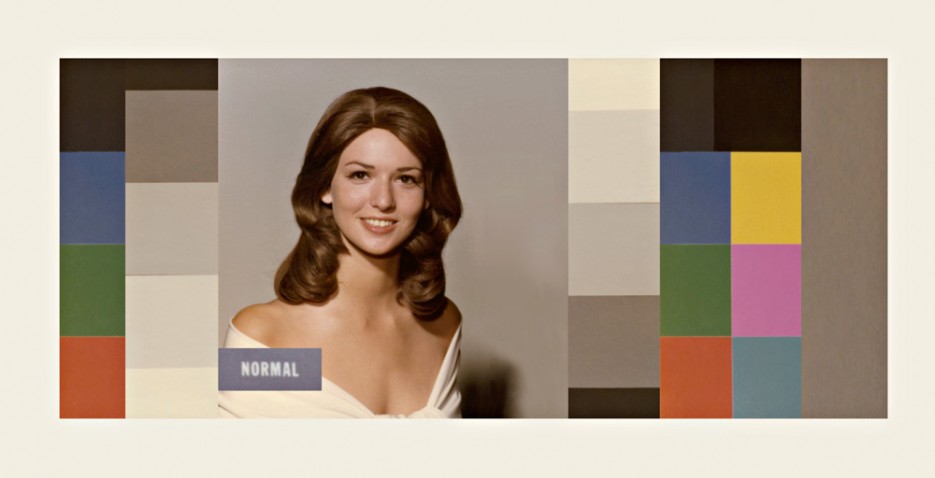
So-called “Shirley Cards” were used by Kodak in the 1950s, 60s and 70s to calibrate colour film for white skin just like Shirley's, which made people of other races appear too dark in the pictures. Ruben Pater writes:
Test images are designed to represent a default, a set of standards for optimal image analysis. But tools are never completely neutral, and their settings reflect the cultural bias of the technicians who calibrate them.
This demonstrates that we as designers don't just need to be aware of political implications inside the designs we produce, but that even the tools and methods we used to arrive at that outcome impose on use the political context of their creation.
Stephan and I released our bachelor project this week. Human Element Inc. consists of three speculative crowdwork services for everyday life.
There's also 200 pages worth of documentation of the process and project. You can download it here [German, 43.5mb]. I put quite some love into the book, but didn't get to take proper photos of it yet. Look at these shitty ones in the meantime:
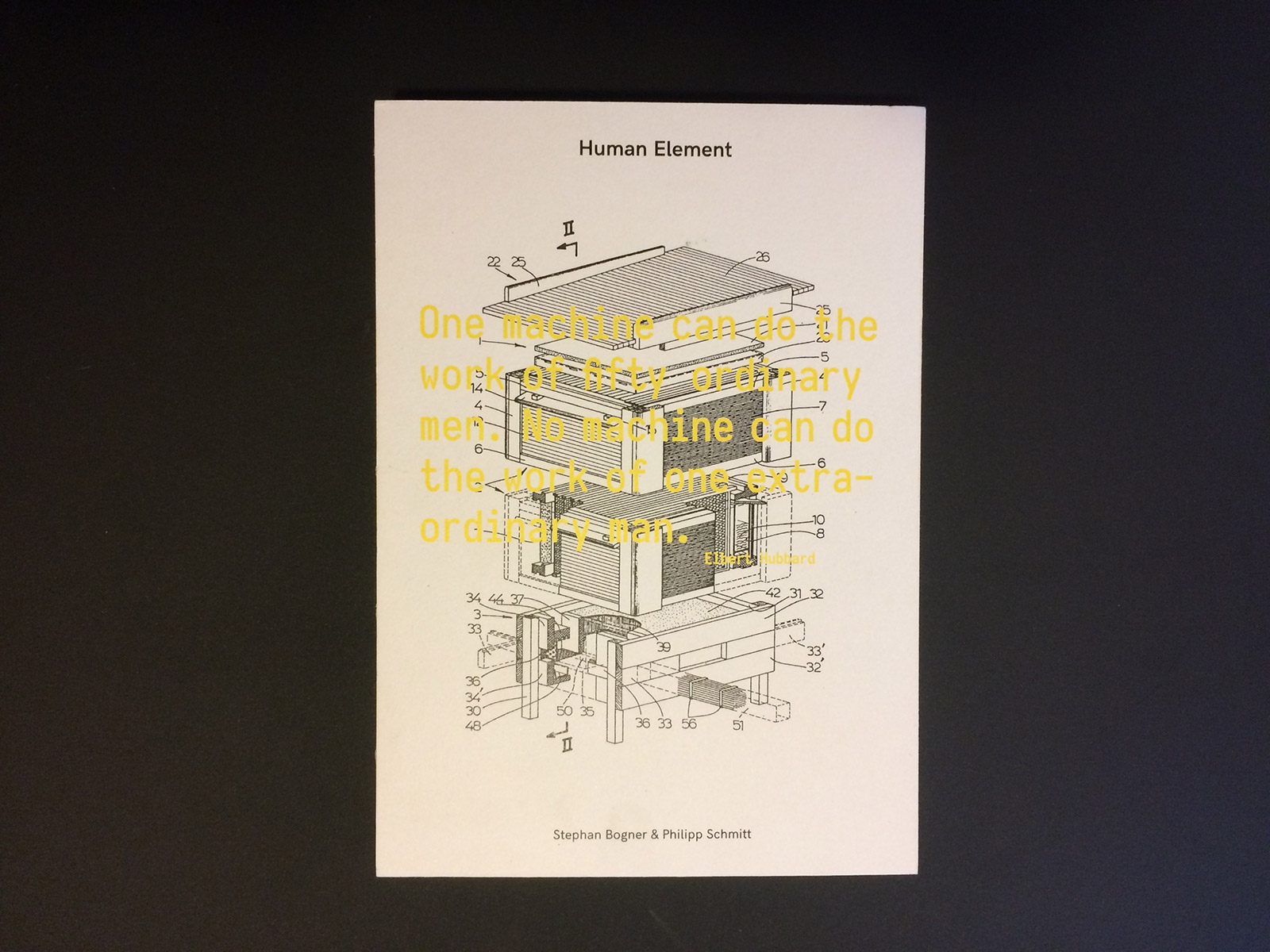
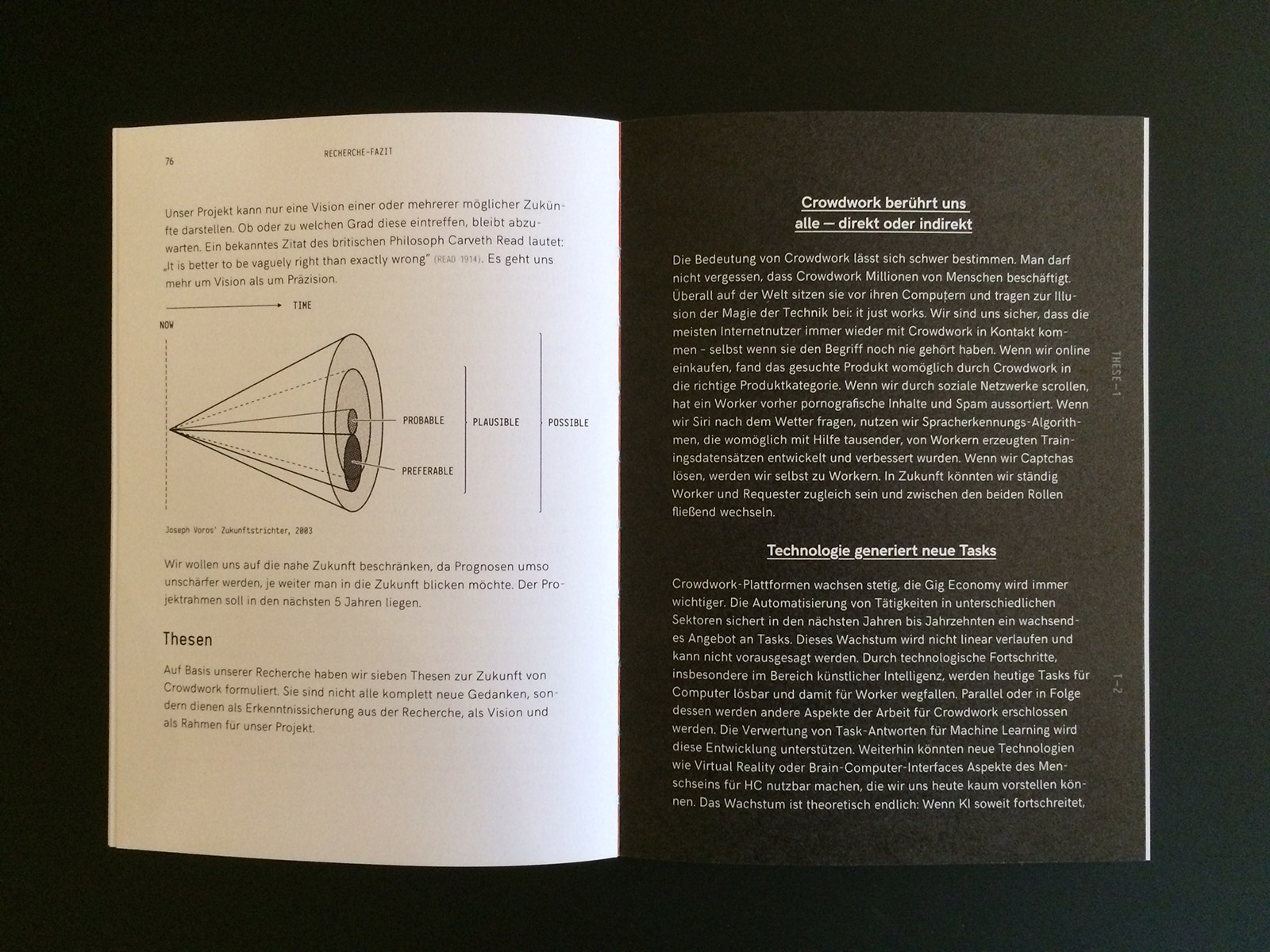
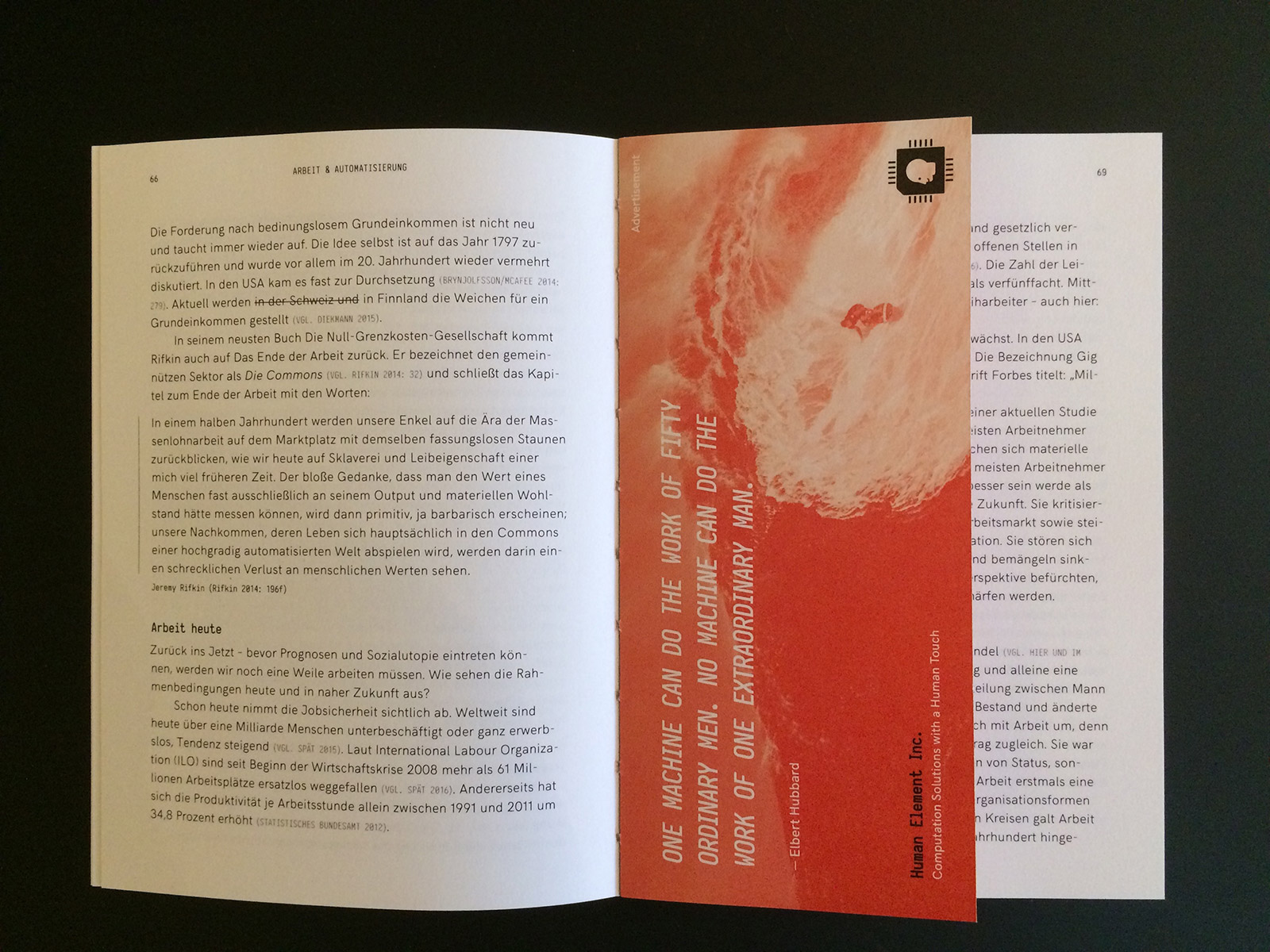
The past few weeks I've been buried in paperwork and writing related to my upcoming Masters applications. Right now, I'm making some generative cover artworks for musician Rolf Gold and work with moovel lab on updates to the Roads to Rome project.
Speaking of which: We're shortlisted for the Information is Beautiful Awards and would appreciate if you give us your vote.
It's even more exciting that we'll be part of the Arts Program at the IEEE VIS 2016 Conference in Baltimore. Benedikt, Raphael and me are going to be there Oct. 23rd to 28th, presenting a paper and huge prints from the project.
Afterwards, I'm going to spend another week in the US. I'll be in New York until 1/11 and in Los Angeles until 5/11. Let me know if you want to have a chat over coffee!
After my trip to Science Gallery in Dublin, I finally got to write up a small documentation page for Unseen Portraits 2. Over the course of the exhibition, which ends today, the installation took almost 20.000 unseen portraits of visitors. I'm very happy with how everything turned out.
Now, here are two more photography projects I saw and liked at Festival Images de Vevey:
Firstly, Icons by Jojakim Cortis and Adrian Sonderegger recreates historic photographs in miniature. I found the attention to detail to be ingenious and the end results really amusing.
Secondly, the photos of Mangini Studio Series by Terry Brown & Gordon Stettinius are not only hilarious, but illustrate very effectively how perception of a personality is led by physical appearance:
For eight years, Gordon Stettinius has played with his own image by growing and dyeing his hair and sculpting his beard for Terry Brown to take regular headshots of him in the purest American tradition of studio photography. While he changes from one look to another, the artist is confronted with society’s perception of him and what started as a simple artistic project soon leads to great introspection. This wacky series illustrates the absurdity of prejudice based on physical appearance through a gallery of flamboyant characters embodied by Stettinius himself, giving the impression that the artist has lived 1,001 different lives.
Catherine Zuromskis, author of Snapshot Photography, argues that snapshot photos are not meaningless and too ubiquitous, but part of a cultural ritual.
In a recent essay, Zuromskis also briefly touched on Camera Restricta and explained why amateur photographers might be just fine without my camera after all:
[Camera Restricta is] a digital camera that uses Global Positioning System (GPS) data to prevent the user from taking photographs in overly photographed locations. While a device like this suggests that our compulsion to repeat ourselves is so great that we need technology to push us to be more creative, I would suggest that this tendency toward convention represents more than just a lack of originality on the part of amateur photographers. Rather, it is central to what personal photographs mean. Subscribing to photographic conventions is a way of using photography not just to document the world, but to frame our relation to it, to cast our lot with a particular group and to craft our identity through a constellation of images. Unlike fine art photography, personal photography is less about creating something wholly unique and more about producing and circulating an image that fits a particular ideology.
My project looked at snapshot photography as documentation ad infinitum. Seeing it as an endeavour to “craft our identity through a constellation of images” opens up for new investigations. Can you systemize identity creation through photos? Do certain times or places carry in their photographic motive a specific ideology or identity? And if so, can this be manipulated through interventions to the site, e.g. as a means of urban planning?
For the past weekend I've been at Festival Images de Vevey, Switzerland. The festival is Switzerland's first visual arts biennale and I had the pleasure to present Camera Restricta.
Images presents photography exhibitions scatttered over the city of Vevey. What makes the festival great is that they've gone well beyond displaying photos on Gallery walls, but sensitively integrate them into the cityscape: on large-scale prints that cover entire facades, in hotel rooms, underwater, outdoors, in trees, etc. Often, a photo will be so well placed that the image or series is enhanced considerably by the surroundings. I was very impressed and had a wonderful time with the super-friendly staff! Images is still on until October 2, 2016.

During the weekend, I discovered several impressive photographs that I'd like to share now (and maybe next week):
Firstly, there's Simon Roberts, whose series The Last Moment very much relates to my own interests in that it investigates amateur photography in public spaces.
Another project that really impressed me was BYE BYE by Michael Schirmer. He took globally recognizable photos and removed all traces of the protagonists, thus creating a series of uncomfortably incomplete sceneries. You immediately start to reconstruct what should be there:
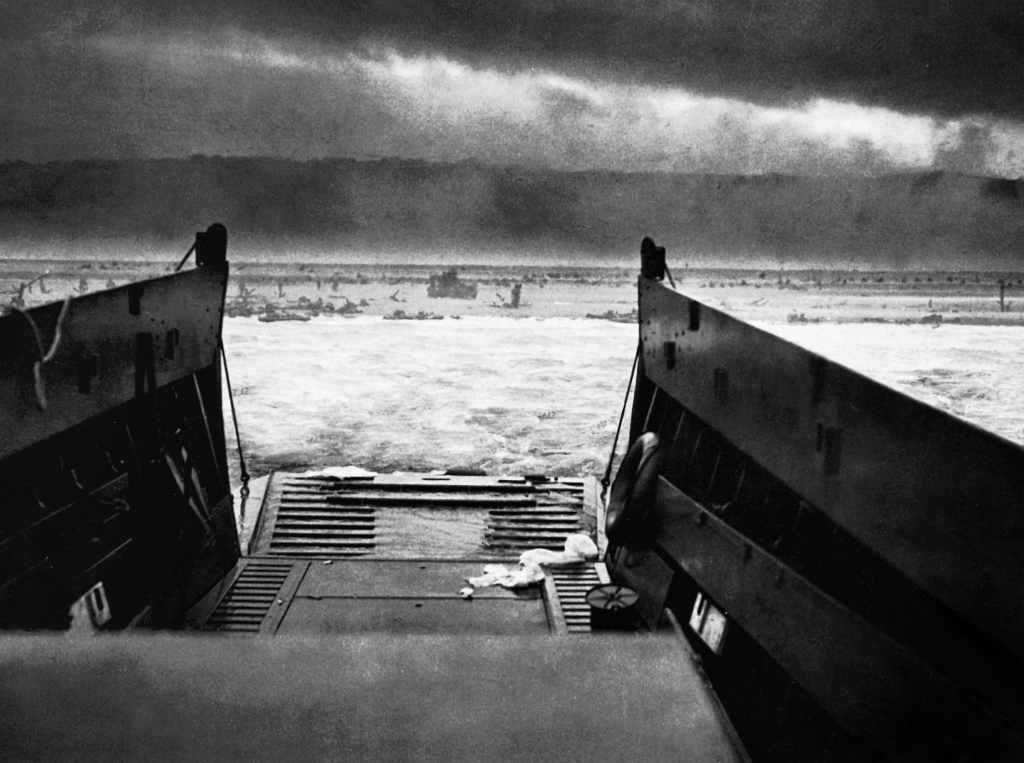
I've moved out of my old apartment over the weekend, which is sad. But this site moved to a new font: HK Grotesk by Alfredo Marco Pradil, which is nice. It also deploys via git now. I think I can start to call this command-line thing a “CMS”.
Not that anyone would care, but I finished two books recently: Firstly, A Burglar's Guide to the City by Geoff Manaugh, author of the fantastic BLDGBLOG. Really enjoyed this one!
Studying architecture the way a burglar would, Geoff Manaugh takes readers through walls, down elevator shafts, into panic rooms, and out across the rooftops of an unsuspecting city.
Then there's Utopia by Thomas More. It's a classic, but in there's not much to it beyond “okay” if you don't invest in studying all the political background info (which I did only shallowly).
I decided that calling them weeknotes doesn't imply that I need to publish them weekly.
Just over one month ago, I finished my Bachelor Degree in Interaction Design and went straight into design-hibernation. I travelled to Denmark to visit old friends and stayed in Croatia for a week for defrosting. I got a tan on my forearms.
I'm working on a small update for Roads to Rome and do some graphic design work for a friend's musical endeavours. I'm also available for smallish freelance projects or collaborations!
Apart from that I'm researching programs for a Master's degree in Design to start next year. At HfG we were taught excellent fundamentals and a structured, analytical way of design for problem-solving. I'm looking for a complementary program now: an experimental approach that questions what else design could be.
I'm mostly writing this for sorting my thoughts, but please email me if you have any suggestions!
What's next? I'll be in Dublin at Science Gallery the first weekend of September. Then, Camera Restricta is part of the biennal Images Festival in Vevey, Switzerland from 10 Sept. 10th to Oct. 2nd. See you there on the 16th!
It's been a while. I've been camping in an editing room for the past days, cutting a video for my bachelor project. It's all coming together now after all and about to be finished.
In the meantime, the exhibition SEEING has launched at Science Gallery in Dublin together with Stephans and my piece Unseen Portraits 2. We're very proud of our first real exhibition ever, still praying that nothing will break. Visitors took more than 3.500 unseen portraits in the first week and you can see all of them online here.
On June 28th, Apple was granted a patent. This one is particularly interesting for me, because it in some way transforms my Camera Restricta from speculation into prediction. The patent introduces a system that uses the iPhone's camera detecting an infrared signal in order to prevent photo capturing in certain locations. There's a band playing on the patent illustration (see below).
Wow! It's intriguing and terrifying. With Camera Restricta, I had imagined a GPS-dependent restriction system, which obviously is easy to disable. Either you turn off GPS, or – if that is not an option – you wrap your camera in tinfoil to get the shot. Now the Apple system transmits information invisibly via the very sensor that you're trying to take the photo with. There is no opt-out.
Let's see if this is going to become a reality.
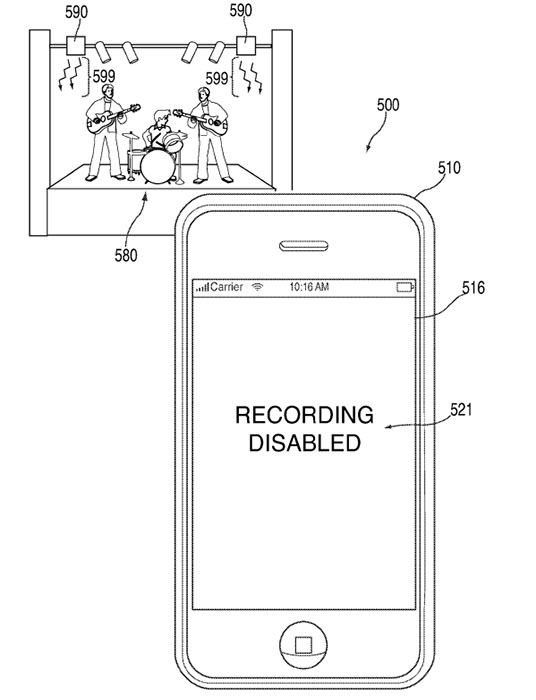
(C) Image: USPTO
I missed last week's note, so here's a double. The last weeks of my bachelor project have begun, the pulse quickens. The project is about a possible future of crowdwork (i.e. online microjobbing) where everyone can become worker or employer at any time and switch between those roles constantly. There is also a fictional company named Human Element. If anyone is reading this – stay tuned.
Three other good things of the kind that I'd share online happened in the last week:
Camera Restricta was honored Student Notable at the Core 77 Design Awards in the Speculative Concepts category. There's some great work amongst the winners that you should check out.
Also, Stephan and I finished and boxed the Unseen Portraits 2 exhibit for Science Gallery Dublin, which is good. Now we really hope that it will work. It's our first interactive exhibit, which is scary.
I bought a new book, too. It's the Haiku Book by artist Rafaël Rozendaal:
thinking about
doing sit-ups
never mind
He has a lot of them online for free, too.
I'm already wondering I should turn weekly to monthly notes. There's just not that much happening here. Maybe this is some kind of a link-sharing thing?
Watch Keiichi Matsudas Hyper Reality, if you haven't already. It's a bubble gum coloured vision of a world where Analog and Digital have merged. My favorite moment is at 04:00 when the VR is turned off — revealing physical tracking markers and technology that keeps the virtual layer in place.
While thinking about what I should do this summer when I finish school, I made some progress in The Art of Travel. The chapter I'm currenly reading deals with how we feel obliged to visit certain sights when we travel somewhere.
Travel twists our curiosity according to a superficial geographical logic, as superficial as if a university course were to prescribe books according to their size rather than subject matter.
The accumulation of places that apparently make out a city or region can't possibly all match one's interests. Still, guidebooks collect “must-see” locations and try to make you feel for not seeing this and that.
Stephan and I built a better testing setup for the Unseen Portraits exhibit and it's coming along nicely. A friend is helping us with building a camera mount. Thanks, Jan!
BA-related, we had a mid-term presentation on Wednesday that went pretty smoothly. There are so many ideas slowly starting to take shape. I'm excited to start making things.
On the nerdy side, I wrote a command line interface for my website. It's a static site, built from templates and a content.json file using grunt-bake. Before, I had to manually create a note file, pick an URL and add the metadata to the content.json. With pscli (philipp schmitt command line interface ;) I can create notes from the terminal, fast. This may or may not prolong my blogging experiment.
While it’s getting summer outside, I’ve spent the whole weekend in the office. We’re building an exhibit for Science Gallery Dublin. It is an adapted version of my Unseen Portraits project from last year, but interactive for the visitors.
This week I’ve been impressed with Sunspring, a screenplay written entirely by a computer program. Not only did the software write the script, it then went on to manipulate online votes to make sure it won the contest. Read about it here, it’s hilarious.
Week one of what? I’ve had a blog before. I started it mainly because I was excited about creating a Wordpress theme and abandoned it soon afterwards. Still, sometimes I wish I had a place to post a note that exceeds 140 characters. This thing might become such a place or be abandoned soon, too. The format is inspired by precious.
Stephan and me are busy working on our bachelor project. It’s an exciting time for me — excitement to get to devote four months to a project while constantly worrying if everything is going to work out just fine. Are we working too slow, too fast, on the right things? It will be fine.
On another note, I’m currently reading The Art of Travel. It is not a book telling you where to travel to, but looks at why we really wanted to go there in the first place — travel philosophy. Here’s a (quite insignificant) paragraph about flying:
Food that, if sampled in a kitchen, would have been banal or even offensive, aquires a new taste in the presence of the clouds (like a picnic of bread and cheese that delights us when eaten on a cliff-top above a pounding sea). With the inflight tray, we make ourselves at home in this unhomely place: we appropriate the extraterrestrial landscape with the help of a chilled bread roll and a pastic tray of potato salad.
I enjoyed writing this.